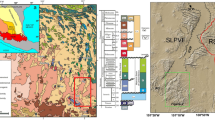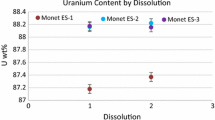Abstract
Recent data in the biological literature suggest that the natural zeolite erionite may be more tumorigenic than asbestos minerals. Because of its potential biological importance, a technique has been developed to facilitate detection of erionite in tuffaceous rocks to a lower limit of detection (LLD) between 100 and 500 ppm. The method involves the use of automated X-ray powder diffraction instrumentation with long count times, as much as 360 s/step. The presence of interfering phases, such as smectite or clinoptilolite, raises the LLD. Ethylene glycol solvation of smectite improves the LLD, and profile fitting with clinoptilolite-bearing mixtures improves quantification. Application of these methods to tuffs from central Turkey allowed improved detection and more accurate quantification compared with previous scanning electron microscope examinations. Use of these methods with tuffs from Yucca Mountain, Nevada, the potential site for the nation’s first high-level radioactive waste repository, showed that erionite occurs sporadically. Erionite is found only in the altered zone directly above the lower vitrophyre of the Topopah Spring Member. This altered zone is anomalous in that is contains a variety of zeolites that are either rare or absent in other Yucca Mountain tuffs. It appears that erionite is restricted to fractures and must have formed under unusual and variable conditions in the altered zone.
Similar content being viewed by others
References
Bariş, Y. I., Özemsi, M., Kerse, I., Özen, E., Sahin, A., Kolaçan, B., and Ogankulu, M. (1975) An outbreak of pleural mesothelioma in the village of Karain/Ürgüp—Anatolia: Kanser 5, 1–14.
Baris, I., Simonato, L., Artvinli, M., Pooley, F., Saracci, R., Skidmore, J., and Wagner, C. (1987) Epidemiological and environmental evidence of the health effects of exposure to erionite fibres: A four-year study in the Cappadocian region of Turkey: Int. J. Cancer 39, 10–17.
Bish, D. L. (1984) Effects of exchangeable cation composition on the thermal expansion/contraction of clinoptilolite: Clays & Clay Minerals 32, 444–452.
Bish, D. L. and Chipera, S. J. (1989a) Revised mineralogic summary of Yucca Mountain, Nevada: Los Alamos Nat. Lab. Kept. LA-11497-MS, 68 pp.
Bish, D. L. and Chipera, S. J. (1989b) Comparison of a solid-state Si detector to a conventional scintillation detector-monochromator system in X-ray powder diffractometry: Powder Diffraction 4, 137–143.
Broxton, D. E., Bish, D. L., and Warren, R. G. (1987) Distribution and chemistry of diagenetic minerals at Yucca Mountain, Nye County, Nevada: Clays & Clay Minerals 35, 89–110.
Carlos, B. A. (1985) Minerals in fractures of the unsaturated zone from drill core USW G-4, Yucca Mountain, Nye County, Nevada: Los Alamos Nat. Lab. Rept. LA-10415-MS, 55 pp.
Carter, J. R., Hatcher, M. T., and Di Carlo, L. (1987) Quantitative analysis of quartz and cristobalite in bentonite clay based products by X-ray diffraction: Anal. Chem. 59, 513–519.
Chipera, S. J. and Bish, D. L. (1989) The occurrence and distribution of erionite at Yucca Mountain, Nevada: Los Alamos Nat. Lab. Rept. LA-11663-MS, 20 pp.
Chung, F. H. (1974) Quantitative interpretation of X-ray diffraction patterns of mixtures. II. Adiabatic principle of X-ray diffraction analysis of mixtures: J. Appl. Crystallogr. 7, 526–531.
Coffin, D. L., Peters, S. E., Palekar, L. D., and Stahel, E. P. (1989a) A study of the biological activity of erionite in relation to its chemical and structural characteristics: in Proceedings of Biological Interaction of Inhaled Mineral Fibers and Cigarette Smoke, A. P. Wehner, ed., Battelle Press, Columbus, Ohio, 313–323.
Coffin, D. L., Palekar, L. D., Cook, P. M., and Creason, J. P. (1989b) Comparison of mesothelioma induction in rats by asbestos and nonasbestos mineral fibers: Possible correlation with human exposure data: in Proceedings of Biological Interaction of Inhaled Mineral Fibers and Cigarette Smoke, A. P. Wehner, ed., Battelle Press, Columbus, Ohio, 347–354.
Davis, B. L. (1988) The estimation of limits of detection in RIM quantitative X-ray diffraction analysis: Adv. X-ray Analysis 31, 317–323.
Deffeyes, K. S. (1959) Erionite from Cenozoic tuffaceous sediments, central Nevada: Amer. Mineral. 44, 501–509.
Klug, H. P. and Alexander, L. E. (1974) X-ray Diffraction Procedures for Polycrystalline and Amorphous Materials: Wiley, New York, 524–525.
Mumpton, F. A. (1979) A reconnaissance study of the association of zeolites with mesothelioma occurrences in central Turkey: U.S. Geol. Sure. Open-File Rept. 79-954, 55 pp.
Palekar, L. D., Eyre, J. F., and Coffin, D. L. (1989) Chromosomal changes associated with tumorigenic mineral fibers: in Proceedings of Biological Interaction of Inhaled Mineral Fibers and Cigarette Smoke, A. P. Wehner, ed., Battelle Press, Columbus, Ohio, 355–372.
Papke, K. G. (1972) Erionite and other associated zeolites in Nevada: Nevada Bur. Mines & Geol. Bull. 79, 32 pp.
Puledda, S. and Marconi, A. (1989) Quantitative X-ray diffraction analysis of four types of amphibolic asbestos by the silver membrane filter method: Intern. J. Environ. Anal. Chem. 36, 209–220.
Rohl, A. N., Langer, A. M., Moncure, G., Selikoff, I. J., and Fischbein, A. (1982) Endemic pleural disease associated with exposure to mixed fibrous dust in Turkey: Science 216, 518–520.
Sèbastien, P., Bignon, J., Barris, Y. I., Awad, L., and Petit, G. (1984) Ferruginous bodies in sputum as an indication of exposure to airborne mineral fibers in the mesothelioma villages of Cappadocia: Arch. Environ. Health 39, 18–23.
Sheppard, R. A. and Gude, A. J., 3rd (1980) Diagenetic fluorite in the Eastgate zeolite deposit, Churchill County, Nevada: U.S. Geol. Surv. Open-File Rept. 80-506, 8 pp.
Simonato, L., Baris, R., Saracci, R., Skidmore, J., and Winkelmann, R. (1989) Relation of environmental exposure to erionite fibres to risk of respiratory cancer: in Non-occupational Exposure to Mineral Fibres, J. Bignon, J. Peto, and R. Saracci, eds., Intern. Agency for Research on Cancer, Lyon, France, 398–405.
Smith, D. K., Nichols, M. C., and Zolensky, M. E. (1982) POWD10. A FORTRAN IV program for calculating X-ray powder diffraction patterns—version 10: The Pennsylvania State University, University Park, Pennsylvania.
Suzuki, Y. and Kohyama, N. (1988) Carcinogenic and fi-brogenic effects of erionite, mordenite, and synthetic zeolite 4 A: in Occurrence, Properties, and Utilization of Natural Zeolites, D. Kallo and H. S. Sherry, eds., Akademiai Kiado, Budapest, 829–840.
Wagner, J. C., Skidmore, J. W., Hill, R. J., and Griffiths, D. M. (1985) Erionite exposure and mesotheliomas in rats: Br. J. Cancer 51, 727–730.
Author information
Authors and Affiliations
Rights and permissions
About this article
Cite this article
Bish, D.L., Chipera, S.J. Detection of Trace Amounts of Erionite Using X-Ray Powder Diffraction: Erionite in Tuffs of Yucca Mountain, Nevada, and Central Turkey. Clays Clay Miner. 39, 437–445 (1991). https://doi.org/10.1346/CCMN.1991.0390413
Received:
Accepted:
Published:
Issue Date:
DOI: https://doi.org/10.1346/CCMN.1991.0390413




